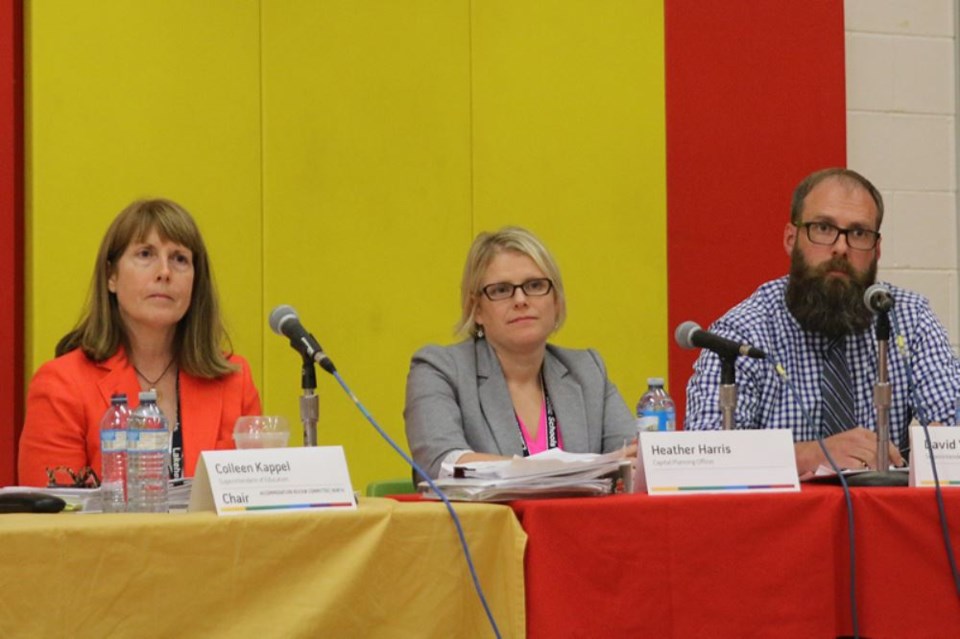THUNDER BAY - If the public school board goes ahead with their plan to close a north side high school the two communities will come together stronger than ever, no matter which building remains open.
That was a message Lakehead Public School Board administrators and the secondary school teachers’ union president tried to convey to members of the audience at the second north side accommodation review committee meeting, which was held Wednesday night at Hammarskjold High School.
The meeting gave members of the public, where more than 100 people were in attendance, the opportunity to weigh in on the board’s renewal plan which proposes closing a number of schools across the city.
There are two options for the north side, with the first proposing closing Hammarskjold and leaving Superior Collegiate and Vocational Institute as the lone high school. It would also consolidate St. James and C.D. Howe public schools into an expanded Vance Chapman Public School.
The second option would leave Hammarskjold open as the high school with Superior converted into an elementary school, allowing the board to close St. James, C.D. Howe and Vance Chapman.
Board officials have previously said the plan is necessitated by the elimination of a provincial government grant to provide top up funding for under capacity schools. Keeping with the status quo is projected to create a $1.5 million annual deficit in operating costs alone.
However, the two north side options have led to a public divide as parents and students from each Hammarskjold and Superior lobby to keep their school open.
Colleen Kappel, board superintendent of education and chair of the north side accommodation review committee, said the two options in the plan are not about trying to create an adversarial relationship between Hammarskjold and Superior camps.
“I think the most important thing is to offer excellent programming for both elementary and secondary students. That’s what the accommodation review process is about and making sure we’re investing in our students and not empty spaces,” she said.
“Really, the students and staff really make the school. It’s how they work together as a community and also offering the breadth of programming the best we can for students.”
Paul Caccamo, president of Local 6A of the Ontario Secondary Schools Teachers’ Federation, acknowledged the potential for looming closures has led to a bit of anxiety for some of his 500 members.
But he sees the renewal plan as a way to reenergize school communities, which have been hit by plummeting enrollment numbers and fewer teachers trying to provide more programs and extracurricular activities.
“We have two successful, vibrant schools each with their own lists of what makes them great,” he said. “The focus is students. It’s not about concrete or mortar or acres. It’s really about kids and providing meaningful programs for them to be successful.”
But the issue remains a passionate one for many of the people in attendance.
Caleb Perzan, a Grade 9 student at Hammarskjold, transferred from Westgate Collegiate and Vocational Institute for the second semester. He said it has only taken a few months for him to appreciate why Hammarskjold is a special school and should have a future.
“This is a level of camaraderie I haven’t seen in any school I’ve visited before,” he said. “Hammarskjold is very open and everyone is aware of each other.”
He said Superior has a number of physical limitations, especially for athletics. He cited the lack of field space for both the junior and senior football teams to practice, as well as the absence of a running track.
Those activities allow students to learn life lessons, expand social circles and pursue postsecondary opportunities, Perzan said.
Katherine Swerhun, a parent of two Superior students, said the state-of-the-art assets, such as science labs, welding and manufacturing facilities and modern technology inside the less than 10-year-old school should be utilized for its original, intended purpose.
“Those students are going to miss out on all those education opportunities. It really is the next step. It’s like a mini college or university school,” Swerhun said. “They need to have that opportunity to have a modern, 21st century education.”
All of the information from the public meetings will be presented to trustees in the final staff report on June 23.
A decision on whether the board will adopt the renewal plan is expected to be made on Oct. 4.
